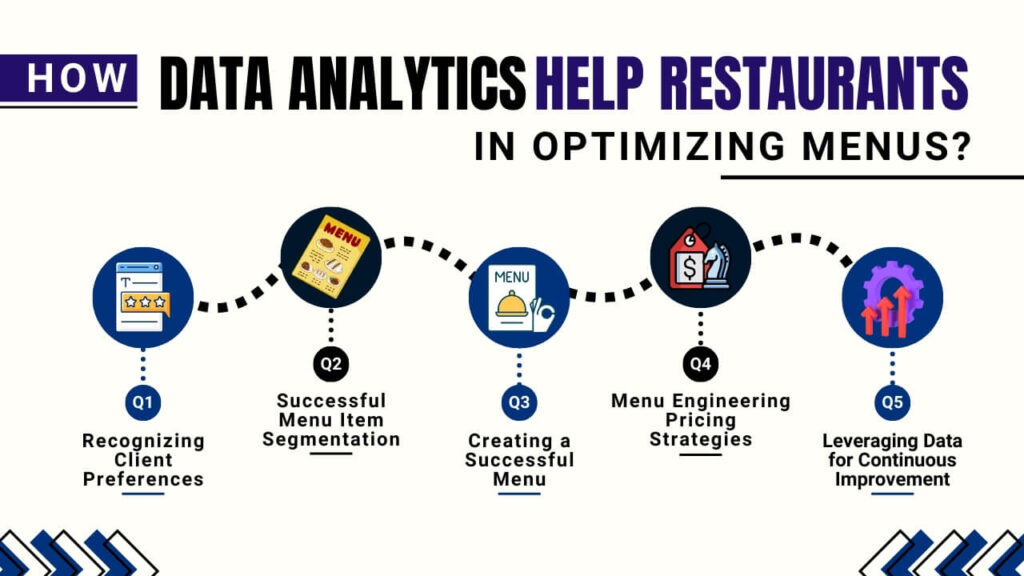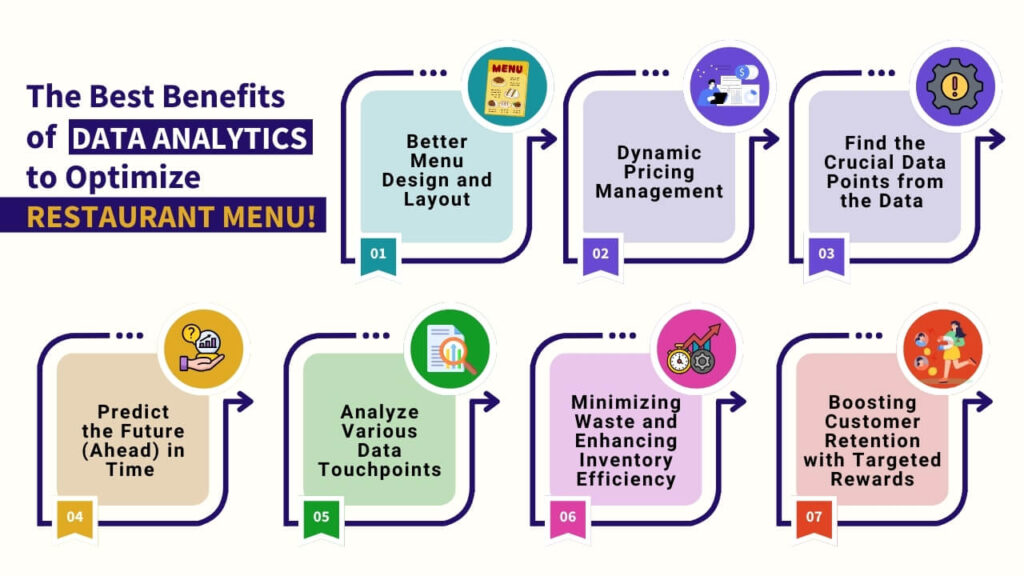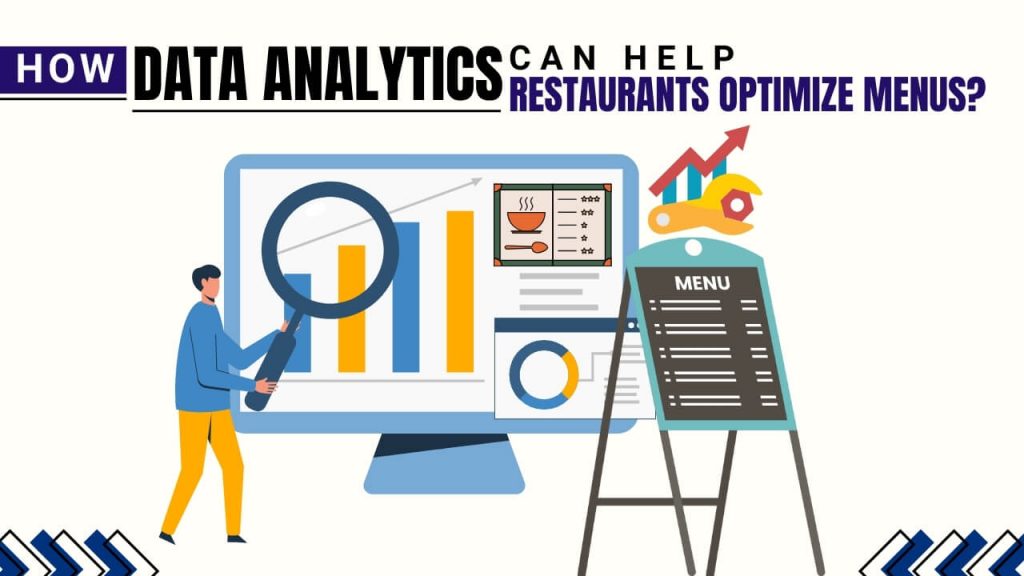Restaurant businesses are always struggling, whether with customer retention, inventory management, profitability, or even optimizing the menu with the right menu items and pricing.
Thank you for reading this post, don't forget to subscribe!If that’s the case with you, then data analytics is the key to success.
Did you know that data-driven restaurants have a 23% higher survival rate? Data analytics can boost restaurant revenue by 10%, cut costs by 5%, and lead to a 2% profit increase from optimized pricing.
Data Analytics helps restaurant businesses analyze customer behavior, customer segmentation, market trends, competitor analysis, and profitability of the business in order to make menu decisions that lead to increased revenue and profitability.
In case you are wondering what is data analytics, how it works, and how it helps restaurants optimize menus for better profitability and improve customer experience, then we have curated this blog to help you out. In this blog, we are considering how data analytics can help restaurant businesses in optimizing menus.
Let’s get into it.
Also Read: Why Does Small Businesses Need Analytics
Why is Menu Analytics Important?
Your menu board is your best salesperson and the primary means of communication with your customers. It is an essential component of the clientele’s experience.
When you have a well-designed menu board with appropriate goods and prices, customers may easily locate what they’re looking for. This leads to faster ordering times, improved order flow, enhanced customer experience, and improved profitability.
Even yet, creating a menu can be difficult for many eateries. It can be challenging to decide which items to highlight and which to remove in the absence of precise data. But, data analytics comes to the rescue.
Data analytics plays a crucial role in optimizing restaurant menus by providing valuable insights into customer preferences, sales performance, and profit margins. It helps identify high-performing items to highlight and underperforming ones to modify or remove, ensuring a streamlined and profitable menu.
Then we’ll delve into how you can make smarter menu decisions – not just with the physical menu board design, but with what items you sell – using data analytics. This can affect everything from food waste to budgeting.
Also Read: How AI is Improving Table-Turnover rate
How does Data Analytics Work?
Data analytics helps businesses to collect all the (structured and unstructured data) also known as raw data, helps and transform these collected raw data into actionable insights. Data analytics includes – data collection, data analysis, data segmentation, data transformation, and data visualization as well.
Sounds pretty overwhelming? It surely is but it is necessary to get the most out of your restaurant data for your business success.
The process typically involves several stages:
- Data Collection: There are several touchpoints for restaurant data that businesses need to collect. Data analytics tool helps businesses in data collection through business POS systems to CRM systems, accounting software, social media, etc.
- Data cleaning: The process is going over and verifying all of the data for errors. For instance, typos, omissions, contradictions, redundant data, and so forth.
- Data analysis: The most crucial phase is data analysis, which is figuring out what the data is trying to tell you. You discover trends, patterns, and conclusions that you might utilize to inform your strategic choices.
- Data Visualization: The technique of displaying data in an understandable and controllable manner is known as data visualization. For instance, making graphs or charts that succinctly display important information.
If the procedure appears overwhelming, the good news is that centralized data analysis tools can assist with the entire process. Implementing a centralized data management system simplifies the data collection process while maintaining data accuracy and accessibility. It also assists restaurant businesses in analyzing data and looking after trends and comparable data points that can help businesses improve operations.
If you are looking for the best data platform, then you can out Livelytics. It is an AI data platform especially curated for restaurant businesses to make the most out of their data.
Also Read: Two Way Data Analytics in Shaping Retail Business
How Data Analytics Help Restaurants in Optimizing Menus?
The future of menu engineering with big data analytics appears promising, with emerging technologies like AI and predictive analytics having the potential to generate personalized menus and pricing strategies.

1. Recognizing Client Preferences:
Understanding what your consumers enjoy and dislike will help you customize your menu to suit their preferences.
Ways to Understand Customer Preferences:
- Examine sales information: Look for patterns among popular and often requested foods.
- Utilize client feedback: Gain insights through online reviews, comment cards, and surveys.
Understanding your audience allows you to focus on things that resonate with your customers while rethinking meals that constantly underperform.
Also Read: How AI Revolutionizes Customer Experience in the Restaurant Industry
2. Successful Menu Item Segmentation:
To properly improve your menu, organize products by profitability and popularity.
The four primary categories are:
- Stars: These dishes are highly profitable and popular, therefore promote them extensively.
- Plowhorses: Low profitability, great demand; consider adjusting prices or serving quantities.
- Puzzles: High profitability but low popularity; boost their attractiveness with better explanations or placement.
- Dogs: They’re not very popular or profitable, so you might want to take them off your menu.
Segmenting your menu items increases your profitability and provides you with a clear roadmap for menu changes.
Also Read: How to Use AI in the Restaurant Business
3. Creating a Successful Menu:
Designing a profitable menu requires more than just aesthetic considerations. It takes strategic preparation to guarantee that your menu layout, descriptions, and price direct customers to make decisions that benefit your bottom line.
Enhancing Menu Design and Layout: Your menu’s arrangement has a significant impact on customer selections. A well-designed menu can emphasize profitable goods and discreetly direct customers to order them.
Best practices for designing menu layouts:
- Put the “Golden Triangle” to use: Customers’ eyes naturally focus on the menu’s center, top-right, and top-left sections first. Put your high-profit products here.
- Add visual components: Use symbols, borders, or boxes to highlight important dishes.
- Limit options: Keep the menu brief, with no more than five to seven choices per category, to avoid overwhelming clients.
Writing descriptive menu item names
The way you describe your food has a huge impact on how tempting they are to customers. Sensory and emotionally appealing descriptions can make dishes attractive.
Advice for creating menu descriptions:
- Emphasize the components and cooking techniques (e.g., “Wood-Fired Artisan Pizza”).
- Make use of sensory phrases (such as “Buttery, Crispy, Savory”) to convey taste, smell, and texture.
- Telling a tale, such as “Grandma’s Classic Apple,” might help create an emotional connection.
Well-written descriptions have the power to increase the perceived worth of your food and entice customers to purchase more lucrative goods.
Also Read: How to Increase Restaurant Sales Without Advertising
4. Menu Engineering Pricing Strategies:
One of the most effective menu engineering tools is pricing. The appropriate pricing plan can improve your meals’ appeal while increasing earnings.
Important pricing strategies:
- Psychological pricing: To make something seem more reasonable, use prices like $9.99 rather than $10.
- Steer clear of dollar signs: Studies indicate that menus devoid of currency indicators make people less cost-conscious.
- Anchor pricing: To give the impression that mid-range dishes are better value, place expensive products close to them.
By intelligently establishing and displaying prices, you can gently persuade clients to spend more without feeling rushed. Finding this balance is essential to preserving a satisfying dining experience while increasing sales.
Also Read: Retail Pricing Strategy
5. Leveraging Data for Continuous Improvement:
Menu engineering is a continual process that needs constant observation and modification; it is not a one-time event. By using data, you can monitor performance, test modifications, and improve your menu to accommodate changing consumer tastes and industry trends.
Also Read: Leveraging AI to Collect Customer Insights
The Best Benefits of Data Analytics to Optimize Restaurant Menu!

1. Better Menu Design and Layout:
Strategic & appealing menu design and layout are of utmost importance for restaurant businesses when it comes to menu engineering. Menu design & layout impacts the customer experience in the restaurant. By leveraging data analytics for menu design, restaurants can create visually appealing and customer-friendly menus that enhance the dining experience while also boosting sales and profitability.
- Strategic Placement of High-Margin Items: Data analytics identifies the most profitable menu items, enabling restaurants to position them in areas of the menu that attract the most attention.
- Highlighting Popular Dishes: Analytics tools can reveal which items are frequently ordered, allowing restaurants to use design elements like bold fonts, colored boxes, or images to draw attention to these crowd favorites.
- Optimizing Menu Categories: By analyzing sales data, restaurants can determine the most and least popular categories (e.g., appetizers, and desserts) and allocate menu space accordingly.
- Less popular items: Data analytics can analyze the less popular items and might bundle them with popular items to increase their appeal and even average order value.
- Customizing Menus for Different Audiences: Analytics can segment customer preferences based on demographics or location, enabling restaurants to design menus tailored to specific customer groups, such as offering kid-friendly layouts in family-oriented areas.
- Enhancing Seasonal Relevance: Data analytics highlights seasonal trends, guiding the placement and promotion of limited-time offers or seasonal specials in prominent areas of the menu to maximize their visibility.
Also Read: Why Does Every Small Business Analytics
2. Dynamic Pricing Management:
In the restaurant menu, pricing is at the core of it. It makes or breaks your restaurant business. So, it is important to get your pricing right. Data analytics plays a crucial role in pricing management by providing actionable insights into customer behavior, sales trends, and demand patterns. With this information, restaurants can implement dynamic pricing strategies that align with real-time market conditions and customer preferences.
If a restaurant identifies peak dinner hours with strong demand for a signature dish, sticking to its standard pricing ensures profitability without the risk of overpricing. Conversely, during low-demand periods, data analytics can guide restaurants to introduce creative offers.
For instance, bundling a high-demand item with a low-demand product can increase the visibility of underperforming menu items while maintaining revenue from popular choices. Additionally, special pricing for off-peak times, such as discounts on appetizers or happy hour deals on beverages, can attract more customers and reduce operational downtime.
Data analytics tools even help businesses by analyzing competitor pricing, customer spending habits, and regional preferences to position their menu items competitively.
Also Read: Cost-Effective AI Solutions for Restaurants
3. Find the Crucial Data Points from the Data:
As data analytics evolves and improves, the future of menu engineering seems promising. Restaurants are already optimizing their menu design and pricing tactics with the use of data analytics in menu engineering, and this trend is probably going to grow in the years to come.
But with the aid of AI-integrated data analytics platforms, restaurant managers and owners can swiftly and precisely evaluate vast amounts of information and can find the crucial data points from this vast amount of data, enabling them to make better choices about pricing and menu design. AI systems, for instance, may be able to spot trends in consumer behavior that human analysts may not see right away, such as which menu items are commonly ordered together.
With these data patterns promptly available to the restaurant businesses, then can highlight these menu items in attractive combo pricing packages. The result? Ultimately, it improves customer experience, loyalty, sales, and profitability. A win-win.
By leveraging the power of data analytics with AI, restaurant businesses can curate menus that are both profitable for the restaurants and appealing to their customers.
Also Read: Benefits of Data-Driven Decision Making
4. Predict the Future (Ahead) in Time:
Data analytics not only helps businesses in analyzing the past and present for menu optimization. But it also helps businesses with predictive intelligence to make predictions about future trends and behavior.
It keeps you ahead of your customers and competitors – giving you an edge in the market and better results for your restaurant business.
This might be helpful for menu engineering since it could assist managers and owners of restaurants in anticipating shifts in customer preferences and modifying their offerings appropriately. With these insights, restaurant managers and owners can decide to expand their menu to include more dishes from a particular cuisine if predictive analytics indicates that it would be popular in the upcoming months.
For example, predictive analytics could reveal that demand for vegan options is likely to surge in the coming months. In response, the restaurant could expand its menu to include more plant-based dishes, such as vegan burgers, salads, or desserts, ensuring they capture the emerging trend. It helps them stay relevant and stay ahead of the competition.
Also Read: How Predictive Intelligence Transforms Retail
5. Analyze Various Data Touchpoints:
Businesses in the restaurant industry may potentially use new data sources with data analytics.
- Restaurants could learn more about the interests and behavior of their customers by utilizing data from wearable technology like fitness trackers providing data on health trends, and enabling restaurants to introduce health-conscious menu options, such as low-calorie or high-protein meals.
- They might also utilize data from online ordering and delivery platforms to learn about which menu items are popular among clients who order from home, helping restaurants adjust offerings based on demand patterns, such as promoting comfort foods during weekends.
- Social media insights allow restaurants to spot emerging trends, such as a growing interest in global cuisines, while weather data helps anticipate demand for seasonal dishes like hot soups in winter or refreshing smoothies in summer.
- Geolocation data enables restaurants to tailor menus to the tastes of their local demographics, such as trendy dishes for young professionals or family-friendly options in residential neighborhoods.
By utilizing these diverse data sources, restaurants can create data-driven menus that resonate with their audience, improve efficiency, and maximize profitability.
Also Read: Data-Driven Social Media Strategies for Business
6. Minimizing Waste and Enhancing Inventory Efficiency:
Food waste in restaurants is quite a big problem, that restaurants are relentlessly working towards to solve it as it can significantly eat into a restaurant’s profits. But data analytics provides actionable insights such as historical sales data, seasonal trends, customer preferences, and much more to accurately forecast demand for specific menu items ad reduce wastage.
For example, if your data shows that a particular dessert sees a spike in orders during weekends but not weekdays, you can plan inventory accordingly, reducing the likelihood of over-preparation.
Additionally, analytics can highlight underperforming dishes that consume valuable resources without contributing to sales. For instance, if a low-demand entrée consistently requires fresh seafood, which has a short shelf life, you might consider either removing it from the menu or offering it as a limited-time special to prevent spoilage.
Restaurants can also use data to repurpose ingredients creatively. Let’s say a salad ingredient like kale isn’t being used as expected; analytics might suggest introducing a kale smoothie or side dish to maximize its use. It minimizes waste and even encourages innovation. Bingo!
All in all, data analytics ensures that your kitchen runs more efficiently, and inventory is aligned with your restaurant needs —all while contributing to a more sustainable operation.
Also Read: AI Solutions for Reducing Restaurant Waste
7. Boosting Customer Retention with Targeted Rewards:
Keeping your customers loyal in a competitive industry requires more than generic discounts. Make it targeted and customized. That’s when data analytics comes to work.
Data analytics helps restaurants delve into customer behavior, identifying what truly resonates with different segments of their audience. For instance, if analytics reveal that a group of customers frequently visits during lunch and orders salads, you could design a lunch loyalty program that offers a free salad after five purchases.
Similarly, data can help track high-value customers—those who frequently order premium menu items or large family meals—and reward them with personalized offers, such as a free appetizer or dessert on their birthday. By making these rewards feel special and relevant, you encourage repeat visits and also deepen the emotional connection with your brand.
Furthermore, data analytics allows restaurants to analyze the effectiveness of these reward programs. Let’s say you introduce a promotion offering a free drink with every entrée; analytics can track how many customers redeem the offer, whether it boosts overall sales, and if those customers return. If a specific incentive isn’t performing as expected, you can tweak it based on insights—perhaps offering a discounted dessert instead.
To Wrap Up!
Data analytics is transforming the food business. Your menu is a critical component of your business. Data analytics can streamline every aspect of it, from the way products are arranged to the frequency of offering and pricing updates.
And, because you’re likely to already have the majority of this information, why not use it? This can improve your sales and customer satisfaction while reducing time, effort, and financial waste.
To adopt a successful data analytics strategy in menu engineering, it is critical to identify goals, collect the necessary data, use the appropriate tools, create an implementation plan, and regularly monitor and optimize.
While, if you are looking for the best-in-class data analytics for your restaurant business, then you can check out Livelytics. It is a feature-rich data platform with all the right features and capabilities build specifically for restaurant business. To know more about it, how it can help you business and everything in between, book a free demo right away.
